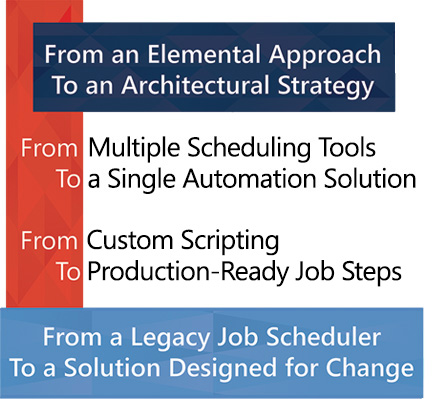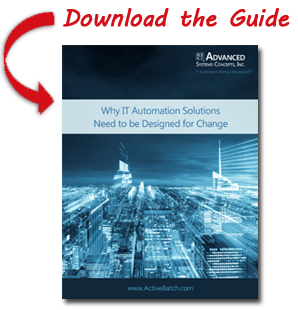According to Gartner, “job-scheduling tools have increasingly moved toward workload automation, reflecting the changing demands of moving from a largely static batch-processing environment to a more dynamic, policy-driven automation platform.” Gartner, Inc. in Magic Quadrant for Workload Automation, Milind Govekar & Biswajeeet Mahapatra, February 27/12.
Today more than ever, IT departments are shedding the role of support department and transforming into a key strategic partner to business operations. The importance of IT operations in making business transactions more fluid, reducing operational costs, and increasing productivity is unparalleled.

From cloud based technologies to the 24/7 consumer driven environment, IT operations is responsible for an expanding number of changes to systems and processes that have a big impact on businesses’ bottom-line. IT departments are operating in increasingly complex environments containing a diverse mix of applications, databases, and platforms. This is why it is essential that businesses’ automation software be better able to handle the complexity and evolving nature of business and IT environments.
From an Elemental Approach to an Architectural Strategy
The elemental approach is often a script-driven solution that relies on platform-specific “point” tools, such as Cron, PMCMD, SQL Server Agent, and Windows Task Scheduler. Relying on scripts offers a temporary fix that often becomes insufficient within a few years as a result of increased complexity due to changes to the business. The elemental approach ends up eating away at resources, as it requires frequent maintenance and manual workarounds to update scripts, resulting in higher costs of IT operations, missing SLAs, operational delays, and system downtimes. Moreover, the elemental approach often creates costly barriers to scalability because elemental scheduling tools traditionally lack any form of enterprise-wide governance and must be implemented on a piecemeal basis, thus being prohibitively expensive to modify.
IT organizations looking towards the future must employ a modern automation solution that is designed for tomorrow’s ever-changing business needs and its accelerating rate of change. That is why an architectural strategy to workload automation is essential to building a solution that can handle increasing complexity, while also providing scalability and extensibility. The architectural strategy to IT Automation is a holistic approach in which the vendor shoulders the burden of complexity by building integrations in order to simplify business and their corresponding IT processes. This allows for a dynamic automation strategy that grows with the organization, rather than one that stays static and holds back the organization. Taking an architectural approach to IT Automation allows IT organizations to more quickly respond to business needs while having the extensibility to accommodate future demands.
From Multiple Scheduling Tools to a Single Automation Solution
The use of multiple scheduling tools creates barriers to the building and modification of IT operational and business processes. These traditional scheduling tools only allow for the execution of jobs, scripts, or tasks on a single system, with no communication to other systems, thus often requiring manual intervention. Using a single automation solution creates a vertical, open system of communication between jobs and systems. For example, you could set a job to trigger on systemB after another job is successfully run on systemA. While point schedulers serve the immediate needs of a given solution, they are not equipped to handle the application diversity of today’s business environments.
A unified automation solution provides a way for IT organizations to support dynamic business needs by automating, for example, managed file transfers, data extractions, transfers and uploads, workflows, applications, processes, across physical, cloud, and virtual systems. Utilizing a single automation tool increases IT agility and response to business needs, simplifies time-consuming tasks, increases productivity using a robust event architecture not driven just by date and time scheduling, and ultimately reduces operational costs.
From Custom Scripting to Production-Ready Job Steps
Many of today’s legacy job schedulers are script-driven solutions that require time-consuming hard-coding by a developer. In order for businesses to remain competitive, IT operations must be timely, efficient, and fluid in their transitions. In order to achieve the balance between business and IT, we must redefine tomorrow’s IT Automation today. Modern automation solutions can no longer act as a mere “script wrapper”, but rather they must be designed for removing the complexity from IT’s shoulders so that change can be implemented more rapidly.
For example, having a production-ready library of job steps or activities eliminates time spent on writing and QA’ing lines of code, thus freeing up developers’ time to tackle higher level tasks. An integrated job steps library removes the burden of building and maintaining scripts from the end-user and places it on the vendor.
Migrating from a legacy job scheduler can often seem like an impediment to business/IT operations, however with the right architecture in place, migration can be a smooth and reliable process. With modern workload automation solutions, taking an architectural approach does not require a full blown consolidation strategy wherein IT organizations must migrate all at once. Advanced Systems Concepts has found that the majority of our customers adopt a phased migration strategy whereby a single process is identified and automated first, with complimentary processes building upon this until a complete migration is achieved.
A solution designed for change will take on the challenges we face today and anticipate those in the future to redefine the modern workload automation plane. In doing so, IT Automation should reduce errors from manual operation, reduce slack time, improve resource utilization levels, improve batch processing, and lower operational costs. The modern architectural strategy bridges the boundaries between multiple systems and processes and provides a unified, enterprise-wide solution to manage these critical dependencies.
Tweet @ActiveBatch with the hashtag #redefiningITautomation to tell us how you are using IT Automation to improve your operations.

